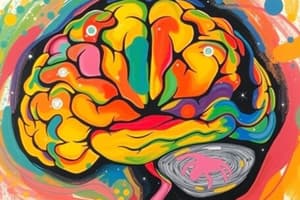Podcast
Questions and Answers
Which part of the nervous system consists of the cerebrum, cerebellum, brain stem, and spinal cord?
Which part of the nervous system consists of the cerebrum, cerebellum, brain stem, and spinal cord?
- Somatic nervous system
- Central nervous system (correct)
- Autonomic nervous system
- Peripheral nervous system
What is the main function of the peripheral nervous system?
What is the main function of the peripheral nervous system?
- Transmit information to and from the central nervous system (correct)
- Regulate involuntary bodily functions
- Control voluntary movements
- Process and coordinate information
Which factor greatly affects how a cell functions and promotes homeostasis?
Which factor greatly affects how a cell functions and promotes homeostasis?
- pH levels (correct)
- Temperature
- Oxygen levels
- Nutrient intake
What does the central nervous system consist of?
What does the central nervous system consist of?
What is the main function of the peripheral nervous system?
What is the main function of the peripheral nervous system?
Which part of the nervous system regulates involuntary bodily functions?
Which part of the nervous system regulates involuntary bodily functions?
What are the components of the central nervous system?
What are the components of the central nervous system?
Which system consists of all nerves outside of the spinal cord?
Which system consists of all nerves outside of the spinal cord?
What is the function of the autonomic nervous system?
What is the function of the autonomic nervous system?
Which part of the nervous system transmits information to and from the central nervous system?
Which part of the nervous system transmits information to and from the central nervous system?
What does a cell need to function correctly?
What does a cell need to function correctly?
What greatly affects how a cell functions?
What greatly affects how a cell functions?
Which part of the nervous system is responsible for voluntary processes?
Which part of the nervous system is responsible for voluntary processes?
How many pairs of cranial nerves are included in the peripheral nervous system?
How many pairs of cranial nerves are included in the peripheral nervous system?
Which nervous system is responsible for the fight or flight response?
Which nervous system is responsible for the fight or flight response?
Which part of the brain is known as the fear center?
Which part of the brain is known as the fear center?
What is the role of the parasympathetic nervous system?
What is the role of the parasympathetic nervous system?
What regulates hormone release from the pituitary gland?
What regulates hormone release from the pituitary gland?
Which part of the nervous system impacts various bodily functions by secreting hormones such as oxytocin and melatonin?
Which part of the nervous system impacts various bodily functions by secreting hormones such as oxytocin and melatonin?
What is the function of cerebrospinal fluid?
What is the function of cerebrospinal fluid?
Which part of the brain includes lobes with distinct functions?
Which part of the brain includes lobes with distinct functions?
What are the protective mechanisms of the brain?
What are the protective mechanisms of the brain?
What part of the nervous system regulates unconscious processes?
What part of the nervous system regulates unconscious processes?
What part of the brain plays a role in fawning and appeasing situations?
What part of the brain plays a role in fawning and appeasing situations?
Study Notes
Neuroscience and Nervous System Overview
- The somatic nervous system, responsible for voluntary processes, receives sensory input through dorsal roots and delivers motor output via ventral roots to muscles.
- The peripheral nervous system includes 12 pairs of cranial nerves and nerves in the cervical, thoracic, lumbar, and sacral regions.
- The autonomic nervous system, which regulates unconscious processes, consists of the sympathetic and parasympathetic nervous systems.
- The lobes of the brain include the frontal, parietal, occipital, and temporal lobes, each with distinct functions.
- The sympathetic nervous system, part of the autonomic nervous system, is responsible for the fight or flight response and has short preganglionic nerves.
- The parasympathetic nervous system is responsible for rest and digest functions and has long preganglionic nerves.
- The amygdala is the brain's fear center, and the prefrontal cortex plays a role in fawning and appeasing situations.
- The communication in the nervous system occurs through nerves, hormones, and the hypothalamus and pituitary gland.
- The pituitary gland secretes hormones such as oxytocin and melatonin, impacting various bodily functions.
- The brain communicates with the body through nerves and hormones, with arterial flow regulating hormone release from the pituitary gland.
- Cerebrospinal fluid, produced by the choroid plexus, flows through ventricles and acts as a cushion to protect the brain during physical activity.
- The brain's protective mechanisms include the dura mater, arachnoid, and pia mater, as well as cerebral spinal fluid, which provides nourishment and protection.
Studying That Suits You
Use AI to generate personalized quizzes and flashcards to suit your learning preferences.
Description
Test your knowledge of the nervous system and neuroscience with this overview quiz. Explore topics such as the somatic and autonomic nervous systems, brain lobes and functions, neurotransmission, and protective mechanisms of the brain. This quiz covers essential concepts for understanding the intricate workings of the nervous system.




